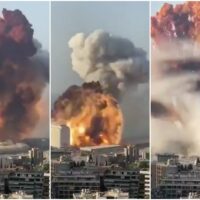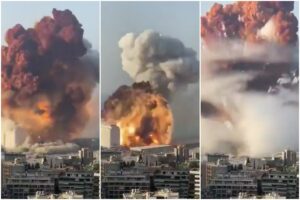
On Tues 4th August 2020, an enormous explosion occurred in the city of Beirut, Lebanon – causing widespread destruction on a scale rarely seen outside war zones. The last time I remember seeing such an event was in Tianjin, China in 2015. There was another building destruction in Tehran in 2017 – the Plasco building. Some friends of mine did some investigation into that incident and posted their findings via facebook.
Whenever something like this happens, where we see unusual destruction, and a strange-looking explosion, I often get flurry of messages or I get tagged on social media – as people wonder if what happened may involve exotic technology or that things “may not be as they appear.” However, as with the Tianjin event – and all similar ones, I don’t want to jump to any conclusions. Neither do I necessarily want to spend many weeks or months investigating the event. Here, therefore, I will point out a few thoughts and observations about the Beirut explosion, and make some comparisons to what happened on 9/11. Readers can perhaps use these ideas as “signposts” for their own investigations.

In Beirut, before the huge explosion, we saw some smaller flashes happening on the building which was near or at the centre of the huge blast.
- The building(s) was/were on fire before the enormous explosion.
- There was an enormous and powerful blast wave which several people recorded and this caused enormous destruction and knocked people down – even those that were about ½ to 1 mile away from the blast. This blast wave was probably travelling at super-sonic speed – so we could see the “dome” of it spreading out. (The visibility of the wave is caused by water vapour in the atmosphere re-condensing due to rapid temperature and pressure changes as the blast wave moves out.)
- The building had been on fire for some time before the blast – we could see a plume of smoke had risen quite a distance into the sky – perhaps 200 feet.
- Beirut is in a geographical area which is politically volatile.
So, these are just basic thoughts/observations – which we can then compare to the events relating to the destruction of the WTC complex on 9/11:
- It happened in a politically stable area.
- There was no blast wave and people were not thrown to the ground while recording the events.
- The fire before the WTC destruction was small compared the Beirut building fire.
- There was relatively little damage to surrounding buildings – only the WTC buildings and the Banker’s trust building were irreparably damaged.
If people want to investigate the Beirut explosion, they need to gather evidence such as:
- All available videos
- Thousands of photos – comprising “before and after” images.
- As many witness accounts as possible
- Seismic data
- Map data (what was the building that had the explosion)
- Weather data
- Study of debris
- Study of official documents about the buildings’ construction and history
Only when the evidence has been gathered and studied can you move away from speculation, towards some type of conclusion. Remember, that in the case of 9/11, Dr Judy Wood had been investigating the WTC destruction for 3 years before she began to post any of her findings (and even then, she started in a “low-key” way).
Whilst we can’t trust mainstream media to tell us the truth – for various reasons, as independent researchers, we should not jump to conclusions either. We can remember that the earlier reports and accounts are important to collect – due to the spin and various types of misinformation and even censorship that usually follows. So, gathering initial reports etc is important, but we should then continue to gather evidence carefully, if we want to find out what happened. Also, we shouldn’t expect other researchers to do the work for us, as they may not be interested in studying the event – particularly where there is going to be a language barrier (i.e. in the case of the WTC Destruction on 9/11, most of the media which contained evidence are in English – this is probably not going to be the case with the Beirut evidence.)



